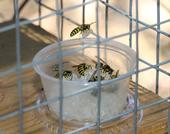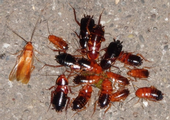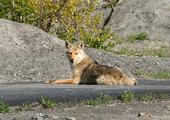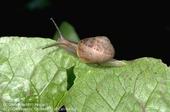- Author: Dong-Hwan Choe
- Author: Kathleen Campbell
- Author: Michael K Rust
- Posted by: Elaine Lander

Many parks, recreational areas, and outdoor venues in California are home to yellowjacket wasps (Vespula spp.). Yellowjackets are commonly attracted to human food items, creating a serious nuisance and a potential stinging threat. If found, nests (usually underground) can be effectively treated with targeted insecticide applications (e.g., dusts containing pyrethroids). However, baiting could be a feasible alternative method to suppress yellowjackets over a wide area, especially if nests cannot be located. Currently, only one active ingredient (esfenvalerate) is registered for use within bait in California to control yellowjackets,...
- Author: Andrew Sutherland
- Posted by: Elaine Lander

Two species of Blatta cockroaches can be common peridomestic pests in California, including the familiar oriental cockroach (B. orientalis) and a relative newcomer, the Turkestan cockroach (B. lateralis, Figure 1). Adults of both species are large (usually one inch or more in length) and conspicuous insects that harbor and breed outdoors within moist crevices around structures, such as subsurface utility ports, voids associated with concrete expansion joints, and soil cracks formed at junctions of landscape and hardscape elements (Figure 2).
From these harborage sites, cockroaches venture out at night to feed on a wide variety of...
- Author: Niamh Quinn

Rodenticides continue to come under scrutiny in California due to issues surrounding the potential for nontarget injury to wildlife and pets. While California already has the strictest rodenticide laws and regulations in the country, there have been recent calls to ban all rodenticide applications in the state. Several Assembly Bills (AB 2596, AB 1687, and AB 2422) have been introduced proposing either bans or major restrictions on rodenticide applications.
Anticoagulant rodenticides have been detected in many species of wildlife worldwide; yet the origins, exposure pathways, and effects of these exposures are not well understood. The origins of these rodenticide exposures from point of application to point of...
- Author: Niamh Quinn

[From the Winter 2017 issue of the UC IPM Green Bulletin]
Rodenticides are essential tools in the IPM toolbox for rodent management. Exclusion and cultural practices, such as landscape management and sanitation, are also very important tools that should be considered when managing rodent populations. However, persistent and chronic infestations often require the use of rodenticides.
Rats (Fig. 1) and mice are vectors of disease such as plague, leptospirosis, and salmonellosis. Commensal rodents are also associated with the onset of...
- Author: Cheryl A. Wilen

[From the May 2013 issue of the UC IPM Green Bulletin newsletter]
For the last 30 years, the primary mollusk (snail and slug) baits used in the landscaping industry have been those containing metaldehyde as the active ingredient. About 10 years ago, iron phosphate came on the market and is now also widely used, particularly in areas where people and pets may encounter the molluscicide. Recently a new active ingredient, ferric sodium EDTA, has become available for both home use and professional pest management.
You can find this active ingredient in new formulations...


